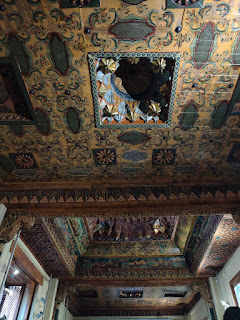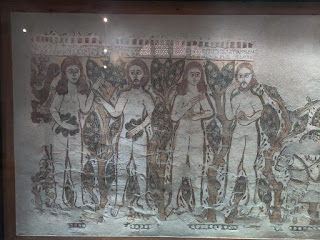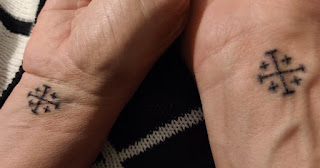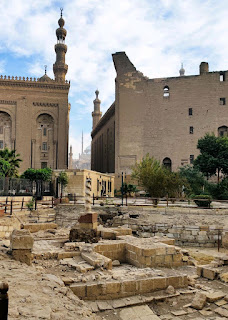This evening, we observed Christmas Eve at Saint Paul's Episcopal Church in Key West, Florida. This is our second time worshipping in Florida and also the second Episcopal Church that we have included in this journey.
The Episcopal Church is often called "Catholic Light," which references the high degree of Mass-like formality in Episcopal worship. Despite the similarity of format, the theology of the Episcopal Church and the Catholic Church have very little in common. The most meaningful area of overlap is in the area of social justice. If you take the Catholic social justice tradition that is manifest in the Society of Jesus (more commonly known as the Jesuits), you will certainly see overlap with the Episcopal Church... but you will never see the Catholic Church add in the ordination of women, affirmation of gay people, or a willingness to share communion with anyone who attends the Mass.
Alike but very different.
What is the Episcopal Church?
The Episcopal Church is the American branch of the Anglican Church, also known as The Church of England. In the taxonomy of American Protestantism, the Episcopal Church has always had a reputation of being the denomination of America's wealthy and powerful ruling class. As an example, the Bush family has been part of the Episcopal Church for many generations, until George W Bush got saved after a long walk on the beach with Billy Graham. After that encounter, W started attending a Methodist church.
As the demographics of America have changed and the theology of the Episcopal Church has also changed, this reputation is mostly an artifact of history now.
Here is a link to a NY Times article that goes deeper into the elite roots of the Episcopal Church, including how the group goes back to the Jamestown Colony [link]. It is a good read, have a look.
There are only about two million Episcopalians in the US now. Most do not attend church very often. The average Episcopal Church on a given Sunday has about fifty people in it. The chart below shows the Episcopal Church with the green line. It seems to suggest that all Episcopal Churches will be empty by 2040 [source].
Interestingly, last week I drove past the other Episcopal Church that I have attended as part of this spiritual pivot, Saint Peter's Episcopal Church in uptown Charlotte. They had a sign out front entitled People of Faith for Climate Justice. This would be an example of how modern Episcopalians are different.
***
We entered the property of Saint Paul's by stepping off the crowded and bustling Duval Street that runs through the center of downtown Key West. When we stepped onto the grounds of the church, it felt like stepping into a different world. The structure of the church was striking. The property had luminaries along its walkways. There was also a beautiful manse on the property. There was a labyrinth, as well. You can see David and MC walking the labyrinth in the video below.
Saint Paul's Priest is The Reverend Donna S. Mote [link]. She was raised in the Southeast and has a long history of serving in the US Military. She not only gave the sermon, but she also sang many of the pieces of music that required a soloist. Her voice was beautiful.
We sat through a full ninety-minute service at Saint Paul's. It was among the most traditional formats that we have encountered during this journey, akin to anything we have seen at an Orthodox Liturgy or at a Catholic Mass.
We said The Nicene Creed.
We had a responsive reading section with the terms Kyrie Eleison at the end.
Because filming in church tends to draw attention, and due to the fact that the church this evening was very full, I recorded some of the singing without lifting my phone up. Here are two of those videos:
Reverend Donna's sermon started with a monologue about the favorite Christmas films of her youth. She seems close to my age, so the films that she mentioned were well-known to anyone raised during the 1970s. She gave special focus to The Grinch, describing the details of the story, with special focus on the redemption of The Grinch through the enlarging of his heart due to his encounter with Cindy Lou Who.
After this, she moved on to more substantial themes about the Incarnation. She described it as the mysterious act of love that changes the way that a person sees life itself. She said that the Communion Table was for anyone who wanted to partake. That is always a beautiful sentiment, as some churches will only offer the Communion elements to adherents of their particular denomination. I have encountered such exclusion multiple times while on this journey and it always gives me pause. The Communion table and the communion elements on it are not the domain of a particular denomination. Instead, it is God's table and needs to be open to anyone who wants to make that connection with the Body and Blood. That Reverend Donna made a point of mentioning the openness of the Episcopal Church's Communion Table felt great.
Here is the Nicene Creed, take a look at its beautiful prose:
I believe in one God,
the Father almighty,
maker of heaven and earth,
of all things visible and invisible.
I believe in one Lord Jesus Christ,
the Only Begotten Son of God,
born of the Father before all ages.
God from God, Light from Light,
true God from true God,
begotten, not made, consubstantial with the Father;
through him all things were made.
For us men and for our salvation
he came down from heaven,
and by the Holy Spirit was incarnate of the Virgin Mary,
and became man.
For our sake he was crucified under Pontius Pilate,
he suffered death and was buried,
and rose again on the third day
in accordance with the Scriptures.
He ascended into heaven
and is seated at the right hand of the Father.
He will come again in glory
to judge the living and the dead
and his kingdom will have no end.
I believe in the Holy Spirit, the Lord, the giver of life,
who proceeds from the Father and the Son,
who with the Father and the Son is adored and glorified,
who has spoken through the prophets.
I believe in one, holy, catholic and apostolic Church.
I confess one Baptism for the forgiveness of sins
and I look forward to the resurrection of the dead
and the life of the world to come. Amen.
Below are the pictures of the service. These include our entrance into Saint Paul's, elements of the service, the Communion, as well as the lighting of candles at the end. You can see how majestic the place is, as well as how many people were present.
Here is a glimpse of the theology in the liturgy that would be described as progressive or liberal. We prayed for the unemployed, the underemployed, the oppressed, prisoners, as well as for our wise use of the Earth's resources.
I really liked seeing these areas of focus. It is the strength of such denominations like the Episcopal Church that perpetuate the tradition of Christians moving forward social change.
Abolition of slavery was a battle moved forward by Christians.
Ending child labor was a battle moved forward by Christians.
Ending racial segregation and Jim Crow was a battle moved forward by Christians.
And so much more.
And that got me thinking...
Some churches have a solid emphasis on the transcendent aspects of the journey to God that is the Christian walk... but one might rightly argue that those same churches may not have enough of a focus on how we live together.
Other churches have a solid emphasis on the worldly considerations of how to live together... but one might rightly argue that those same churches may not have enough focus on the spiritual and transcendent aspect of the journey to the Cross.
Then I considered how the Holy Spirit is described in Episcopal theology. Reverend Donna said that the belief in the Episcopal Church is that the Holy Spirit is encountered when He descends onto the Communion elements of bread and wine. Then the elements are consumed, providing the congregants with an opportunity to encounter the Holy Spirit.
Many of my recent experiences have led me to believe very different (and for me, new) things about the Holy Spirit.
I believe that the Holy Spirit is the aspect of the Godhead that is on the Earth right now, left in the stead of the ascended Yeshua (John 14:26).
I believe that the Holy Spirit can settle on a person in an event best described as a Baptism of the Holy Spirit (Matthew 3:11, Acts 1:5, 1 Corinthians 12:13).
I believe that the Holy Spirit can leave you utterly different, day in and day out and be involved in both the large and small details of your life (2 Corinthians 3:18).
To diminish the work of the Holy Spirit to the simple role of settling upon wafers and grape juice on a weekly basis seems to be missing the mark in a very profound way.
That was a significant line of thinking for me as I sat in Saint Paul's.
***
Overall, the beauty, pageantry, majesty and formality of the Episcopal Church was very welcome on this Christmas Eve. It was a glimpse of a denomination that is rapidly dwindling and will likely all but disappear in coming decades.
As we wandered out into the dark and tropical evening, we shook hands with Reverend Donna. She smiled warmly. Then we again found ourselves in a mass of people out on Duval Street.
We were thankful to have had this experience. We won't have another Christmas Eve service related to this spiritual pivot and this blog. As such, this was a wonderful way to observe the arrival of Immanuel at the end of this most interesting year.
Thanks to Saint Paul's for a fantastic Christmas Eve.




























































































